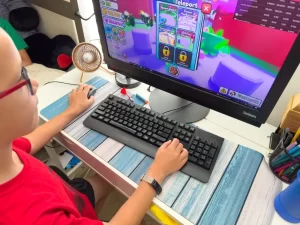Children are facing an escalating crisis of online sexual abuse, with a recent study revealing that 1 in 12 children globally are exposed to such exploitation. Experts warn that the rapid advancement of digital technology and increased smartphone access are contributing to the rise in online abuse cases, particularly in developing nations. Dr. Xiangming Fang, lead author of the study and a research associate professor at Georgia State University’s School of Public Health, emphasized the urgency for public awareness and policy intervention, stating that the internet has become a crime scene where children are exploited at an alarming rate.
The study, reported by CNN and published in The Lancet Child & Adolescent Health, analyzed data from 123 studies conducted between 2010 and 2023. It found that children under 18 are frequently subjected to various forms of online sexual abuse, including solicitation, exploitation, extortion, and the nonconsensual sharing or exposure to sexual images and videos. In 2023 alone, the National Center for Missing & Exploited Children and Homeland Security Investigations received over 36 million reports of suspected child sexual exploitation. The true number is likely even higher, given the many cases that go unreported, suggested Kate Kennedy, director of the Department of Homeland Security’s Know2Protect campaign.
Understanding the different forms of online sexual abuse is crucial to prevention. Researchers define online sexual exploitation as the exchange of sex acts for money, resources, or perceived value, including gifts, affection, or shelter. Online solicitation involves sexual inquiries and long-term conversations, which can lead to the exchange of explicit content. Alarmingly, solicitation often comes not just from adult perpetrators but also from peers. Sexual extortion occurs when perpetrators blackmail victims for money or additional sexual content by threatening to expose intimate images.
Additionally, nonconsensual sharing and exposure to explicit images can occur when images are taken without consent, when a child is unaware, or when AI-generated deepfakes manipulate a child’s likeness onto inappropriate content. Dr. Fang stressed to CNN the profound impact of these abuses, noting that they result in long-term psychological harm and perpetuate abuse with each view of illicit content. These are not harmless images; they cause deep damage, and every failure to remove them prolongs the victim’s suffering, Fang stated.
Experts emphasize that parental awareness and communication are critical in preventing online abuse. Dr. Kara Alaimo, associate professor of communication at Fairleigh Dickinson University, suggests that children who are not educated about online risks and who spend unsupervised time online are at greater risk. Parents should establish open conversations with their children, set boundaries around screen time, and utilize safety features such as Instagram’s parental controls, which allow oversight of contacts without infringing on privacy.
Encouraging offline activities and fostering an environment where children feel safe reporting any concerning interactions is vital. Dr. Deborah Fry, co-author of the study and professor at the University of Edinburgh, stressed the importance of letting children know they can always turn to their families for support.
If parents suspect their child has been a victim of online abuse, immediate action is necessary. Experts recommend reaching out to law enforcement, national organizations like the National Center for Missing & Exploited Children (NCMEC), and the Rape, Abuse & Incest National Network (RAINN) for support and legal guidance. These organizations provide resources, investigation support, and counseling services. Alaimo also encourages parents to seek legal advice to better understand their options for pursuing justice and protection for their child.




